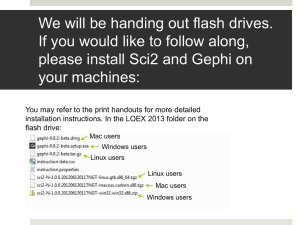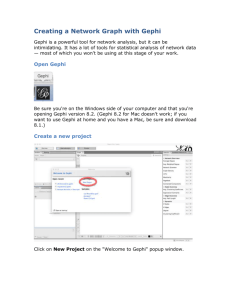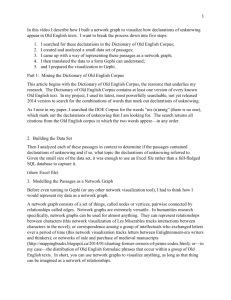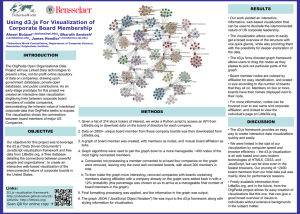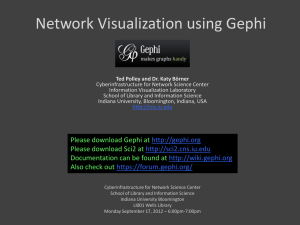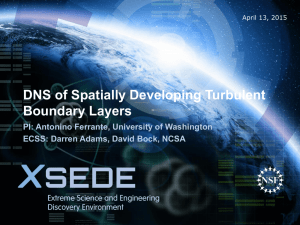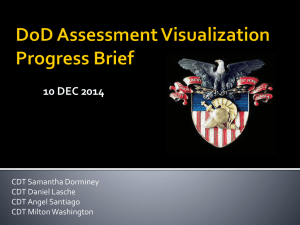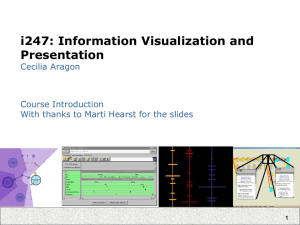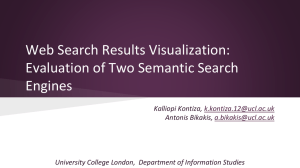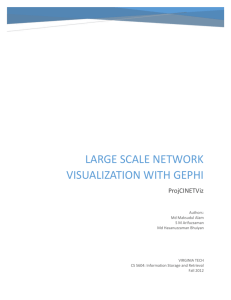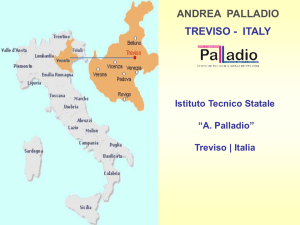Networks: Gephi (and a little bit of Palladio)
advertisement
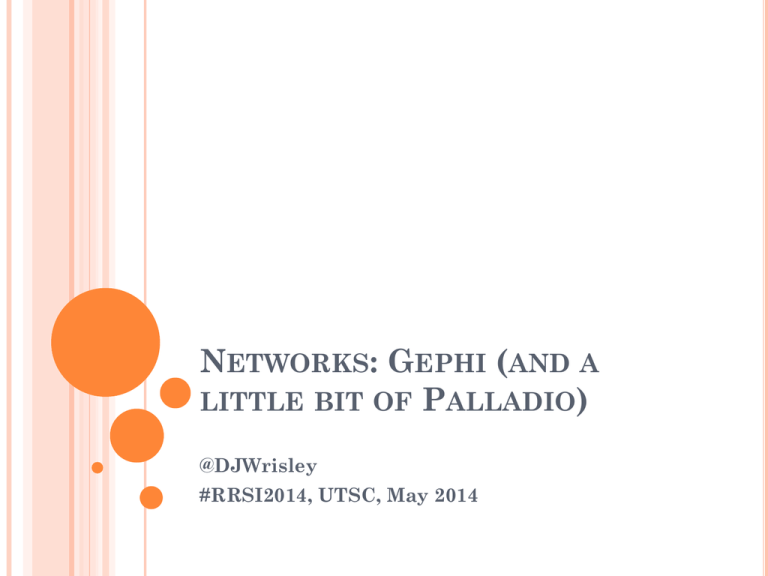
NETWORKS: GEPHI (AND A LITTLE BIT OF PALLADIO) @DJWrisley #RRSI2014, UTSC, May 2014 NETWORKS THEORY, ANALYSIS, VISUALIZATION Network analysis – a term encompassing a wide variety of practices with applications throughout (social) scientific and digital humanistic domains “Network theory concerns itself with the study of graphs as a representation of either symmetric relations or, more generally, of asymmetric relations between discrete objects.” (Wikipedia, 6 italicized words are mine—all debatable in humanist circles) Network theory has its own conceptual vocabulary to express relationships between objects (e.g. betweenness, centrality, density, path length, modularity) – how can we interpret these analytical terms for humanities data? NETWORK THEORY, ANALYSIS, VISUALIZATION (2) Social network analysis SNA looks at relationships between actors – what is the nature of interaction? Latour adds objects in actor-network theory ANT – what could the relation of an actor and an object be? Networks once drawn (drawn by MorettiNetwork Theory, Plot Analysis), are now digitally created and manipulated Powerful way of exploring multidimensional multi-scalar data (Brughmans) SOME BEGINNING REMARKS @ELIJAHMEEKS ON THE NETWORK "The network is not a social network or geographic network or logical network but rather a primitive object capable of and useful for the modeling and analysis of relationships between a wide variety of objects." <https://dhs.stanford.edu/visualization/morenetworks/> BASIC PRINCIPLES (1) Not all study of networks is quantitative (Brughmans on Malkin, 2011), just as every mapping is not made of spatial data onto a map interface Digital tools for network visualization and analysis use tabular data (quantification can be a challenge, metadata adds qualitative contours) Digital tools like Gephi allow both for networks to be explored visually, and for static visuals of them to be exported. It does not allow for sharing. Data visualization is a kind of “problem-posing”; we should avoid fetishizing the final visual. (McCosker/Wilke) – “diagrammatic” thinking BASIC PRINCIPLES (2) Tabular data used by network viz platforms are of two basic sorts Nodes (discrete entities in a network, and any fixed metadata about them – gender, geospatial data) Edges (specific instances of relations between nodes) NB: Gephi does generate a nodes table if it is missing (option: create missing nodes) DIFFERENT TOOLS NETWORK VISUALIZATION TOOLS Gephi (standalone) Palladio (web-based) NetXL Sci² Elijah Meeks https://dhs.stanford.edu/gephi-workshop/ https://dhs.stanford.edu/visualization/more-networks/* Non proprietary code – plug ins Scott Weingart Indiana MOOC on visualization Points of comparison: performance, usability, filter, formats of data ownership, data portability, cost EXAMPLE 1 NB: Examples Increase in Scale ONE TEXT RAMON LLULL, BOOK OF THE LOVER AND THE BELOVED (LATE 13TH) HTTP://WWW.AM.UB.EDU/~JMIRALDA/LLULLTRA.HTML LLULL DATA SNAPSHOT (@DJWRISLEY @TRACEY_DH) NODES (LEFT) EDGES (RIGHT) LLULL’S “SOCIAL” NETWORKS (@DJWRISLEY @TRACEY_DH) LLULL “SOCIAL” NETWORKS, MINUS THE NARRATOR (@DJWRISLEY @TRACEY_DH) ALGORITHMIC LLULL Fruchterman Force Atlas TINKER TAILOR SOLDIER SPY(@HAYAY44) TINKER TAILOR, “THE KARLA COLLECTION” (@HAYAY44) 14TH C MEDIEVAL FRENCH (AROUND JEAN DE MEUN) – STYLOMETRIC ANALYSIS OF 70+ TEXTS J RICHARDS (WUPPERTAL – GERMANY) STYLOMETRIC DATA SAMPLE Open file RRSI stylo experiment 250+ TEXTS OF MEDIEVAL FRENCH – TEST CASE FOR POWER OF STYLOMETRY GIVEN DIALECTAL DIFFERENCE (@DJWRISLEY AND RICHARDS) Parts of gephi interface Visualizing the network using the same file J FACEBOOK NETWORKS VIA @GRANDJEANMARTIN NETWORKS OF NEWSPAPERS 19TH C VIA @RYANCORDELL IMAGE: ORBIS: THE STANFORD GEOSPATIAL NETWORK MODEL OF THE ROMAN WORLD SPACES AND TEXTS – A NETWORK WITH GEPHI @DJWRISLEY VIE DE SAINT LOUIS TEXT - PLACE @DJWRISLEY JERUSALEM – ASPECTED BY FORM @DJWRISLEY PAUL’S EXAMPLES A BRIEF COMPARISON Gephi standalone open source Established large user community = many plug-ins Takes a while to learn Science/humanities use Not easy to share without giving away data Network statistics Palladio web-based free Relatively new Learning curve low Specifically for the humanities simple to deal with data multi-dimensionality Data is not kept “without any barriers” PALLADIO EXAMPLE – SPACE IN LITERATURE Live Example using file “distorted VMP data”
